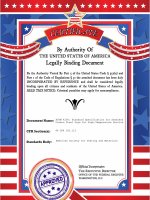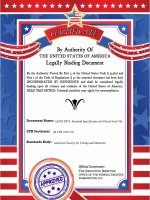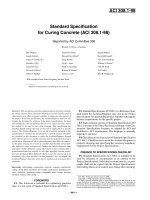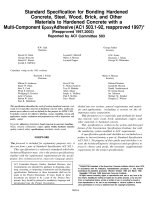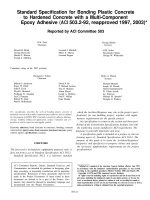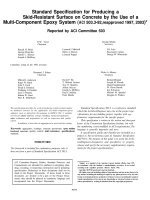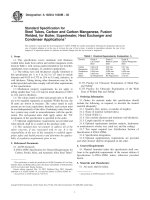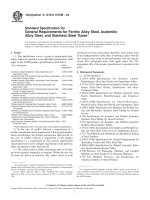Astm a 500 99 standard specification for cold formed welded and seamless carbon steel structural tubing in rounds and shapes
Bạn đang xem bản rút gọn của tài liệu. Xem và tải ngay bản đầy đủ của tài liệu tại đây (318.28 KB, 5 trang )
Ree See
*
Sak car
a
Ean soCo.
Ngày/Date:
tes
NO.
73/25/7235"
¿
|
wom
An American National Standard
oe
AMERICAN SOCIETY FOR TESTING AND MATERIALS
.
~ 100 Barr Harbor Or., West Conshohocken, PA 19428
Reprinted from the Annual Book of ASTM Standards. Copyright ASTM
Standard Specification for
Cold-Formed Welded and Seamless
Carbon
Tubing in Rounds and Shapes’
Steel Structural
| | tcspe
This standard is issued under the fixed designation A 500; the number immediately following the designation indicates the year of
original adoption or. in the case of revision, the year of last revision, A number in parentheses indicates the ycar of last rcapproval.
superscript cpsilon (€) indicates an editorial change since the last revision or reapproval.
A
This standard has been approved for use by agencies of the Department of Defense.
1. Scope
MIL-STD-129
I. This specification covers cold-formed welded and seamless carbon stcel round, square, rectangular, or special shape
structural tubing for welded, riveted, or bolted construction of
ridges and buildings, and for general structural purposes.
1.2 This tubing is produced in both welded and seamless
“sizes with a maximum periphery of 64 in. (1626 mm) and a
maximum wall of 0.625 in. (15.88 mm). Grade D requires heat
treatment.
Note
suitable
welded
may be
|—Products manufactured to this specification may not be
for those applications such as dynainically loaded elements in
structures, etc., where low-temperature notch-toughness properties
important.
1.3 The values stated in inch-pound units are to be regarded
as standard. The values given in parentheses are mathematical
conversions of the values in inch-pound units to values in SI
units.
1.4 The text of this specification contains notes and footnotes that provide explanatory material. Such notes and footnotes, excluding those in tables and figures, do not contain any
mandatory requirements.
2. Referenced
2.t
Documents
ASTM Standards:
A 370 Test Methods and Definitions for Mechanical Testing
of Steel Products?
A 700 Practices for Packaging, Marking, and Loading
Methods for Steel Products for Domestic Shipment?
A751 Test Methods, Practices, and Terminology for
Chemical Analysis of Steel Products”
A94! Terminology Relating to Steel, Stainless Steel, Related Alloys, and Ferroalloys*
2.2 Military Standards:
MIL-STD-163
2.3.
Marking for Shipment and Storage"
Steel Mill Products,
ment and Storage*
Preparation for Ship-
Federal Standards:
Fed. Std. No. 123 Marking for Shipment®
Fed. Std. No. 183
Continuous
Iron and Steel Products>
2.4 AIAG Standard:
B-1
Identification
Marking
of
Bar Code Symbology Standard®
3. Terminology
3.1 Definitions—For definitions of terms used in this specification, refer to Terminology A 941.
4. Ordering Information
4.1
Orders for material under this specification shall contain
information concerning as many of the following items as are
required to describe the desired material adequately:
4.1.1 Quantity (feet or number of lengths),
4.1.2 Name of material (cold-formed tubing),
4.1.3 Method of manufacture (seamless or welded),
4.1.4 Grade (A, B, C, or D),
4.1.5 Size (outside diameter and nominal wall thickness for
round tubing and the outside dimensions and nominal wall
thickness for square and rectangular tubing),
4.1.6
4.1.7
4.1.8
4.1.9
4.1.10
4.1.11
4.1.12
Length (random, multiple, specife; see 11,3),
End condition (see 16.3),
Burr removal (see 16.3),
Certification (see Section 18),
ASTM specification designation and year of issue,
End use,
Special requirements, and
4.1.13 Bar Coding (see 19.3).
5. Process
5.1
‘This specification is under the jurisdiction of ASTM Committee A-1 on Stecl,
Stainless Steel, and Related Alloys and is the direct responsibility of Subcommittee
A01.09 on Carbon Steel Tubular Products
Current edition approved March 19, 1999, Published May 1999, Originally
published as A $00 64, Last previous cdition A 500 - 98.
* Annual Book of ASTM Standards, Vol 01.03.
* Annual Book of ASTM Standards, Vol 01.05.
+ Annual Book of ASTM Standards, Vol 01.01
The steel shall be made by one or more of the following
processes: open-hearth, basic-oxygen, or electric-furnace.
5.2 When steels of different grades are sequentially strand
cast, the steel producer shall identify the resultant transition
* Available from Standardization Documents Order Desk, Bldg. 4 Section D, 700
Robbins Ave., Philadelphia, PA 19111-5094, Attn: NPODS.
“ Available from Automotive Industry Action Group, 26200 Labser Road, Suite
200, Southfield, MI 48034.
ail) A 500
material and remove it using an established
positively separates the grades.
procedure
6. Manufacture
6.1 The tubing shall be made by a seamiess or welding
process.
6.2 Welded tubing shall be made from flat-rolled stee! by
the electric-resistance-welding process. The longitudinal butt
joint of welded tubing shali be welded across its thickness in
such a manner that the structural design strength of the tubing
section is assured.
Note 2—Welded
inside flash.
tubing is normally furnished without removal of the
6.3. Except as required by 6.4, it shat] be permissible for the
tubing to be stress relieved or annealed.
6.4 Grade D tubing shall be heat treated at a temperature of
at least [100° F (590° C) for one hour per inch (25.4 mm) of
sickness.
"7.
TABLE 2
that
Tensile sirength, min, psi (MPa) | 45 000 | 58 000 | 62 000 | 58 000
(310)
(400)
(427)
(400)
Yield strength, rnin, psi (MPa)
33 000 | 42 000 | 48 000 | 36 000
(228)
(290)
(317)
(250)
Elongation in 2 in. (50.8 mm),
254
238
212
238
min, %?
Shaped Structural Tubing
| GradeA | Grade B | Grade Cc | Grade D
Tensile strength, min, psi (MPa) | 45 000 | 58 000 | 62 000 | 58 000
(310)
(400)
(427)
(400)
Yield strength, min, psi (MPa)
39 000 | 46 000 | 50 000 | 36 000
(269)
(317)
(345)
(250)
Elongation in 2 in. (50.8 mm),
254
232
21€
232
min, %2
The following table gives calculated minimum values for longitudinal strip tests;
where an ellipsis (...) appears in this table, there is no requirement
0.180
0.165
0,148
9.134
0.120
0.109
0.095
0.083
0.085
9.049
0.035
7.1 Each heat analysis shall conform to the requirements
specified in Table 1 for heat analysis.
8. Product Analysis
8.1
The
tubing
shall
be
capable
of conforming
to
the
8.2
If product analyses are made, they shall be made using
test specimens taken from two lengths of tubing from each lot
of 500 lengths, or fraction thereof, or two pieces of flat-rolled
stock from each lot of a corresponding quantity of flat-rolled
stock. Methods and practices relating to chemical analysis shall
be in accordance with Test Methods, Practices, and Terminol-
ogy
A751.
Such
product
analyses
shall
conform
requirements specified in Table | for product analysts.
to
the
Grade A
.
.
"
25
23.5
23
22
21
20
19.5
(4.57)
(4.19)
(3.76)
(3.40)
(3.05)
(2.77)
(2.41)
(2.11)
(1.65)
(1.24)
(0.89)
Grade 8
23
22
21
20
19.5
19
18
1
16
18
14
^Applies to specified wall thicknesses 0.120 in. (3.05 mm) and over. For wall
thicknesses under 0.120 in., the minimum elongation shail be calculated by the
formula: percent elongation in 2 in. = 56f+ 17.5.
® Applies to specified wall thicknesses 0.180 in. (4.57 mm) and over. For wall
thicknesses under 0.180 in., the minimum elongation shall be calculated by the
formula: percent elongation in 2 in. = 61f+ 12.
Applies to specified wall thicknesses 0.120 in. (3.05 mm) and over. For lighter
wall thicknesses, elongation shal! be by agreement with the manufacturer.
°The minimum elongation values specified apply only to tests performed prior to
8.3 If both product analyses representing a lot fai] to
conform to the specified requirements, the tot shall be rejected.
shipment of the tubing
conform to the specified requirements, product analyses shall
10. Flattening Test
8.4
Elongation in 2 in. (50.8 mm). min, %
Wall thickness, in. (mm)
Heat Analysis
requirements specificd in Table | for product analysis.
Tensile Requirements
Round Structurat Tubing
| GradeA | Grade 8 | Grade ¢ | GradeD
If only one product analysis representing a lot fails to
he made using two additional test specimens taken from the lot.
oth additional product analyses shall conform to the specified
~vequirements or the lot shalt be rejected.
9, Tensile Requirements
9.1 The material, as represented by the test specimen, shall
conform to the requirements as to tensile properties prescribed
in Table 2.
TABLE 1
Chemical Requirements*
Element
Composition, %
Grades A, B and
D
Heat
Carbon, max
Manganese, max
Phosphorus. max
Sulfur, max
Copper, when copper steel is
specified, min
Product
Grade C
Heat
Analysis
Analysis
Analysis
0.26
ee
0.035
0.035
0.30
"
0.045
0.045
0.23
1.35
0.035
0.035
0.20
0.18
= Product
0.20
AWhere an ellipsis (...) appears in this tadie, there is no requirement.
Analysis
0.27
1.40
0.045,
0.045
0.18
10.1
The flattening test shalt be made
on round structural
tubing. A flattening test is not required for shaped structural
tubing.
10.2 For welded round structural tubing, a specimen at least
4 in.
(102
mm)
in
length
shall
be
flattened
cold
between
parallel plates in three steps, with the weld located at 90° from
the line of direction of force. During the first step, which is a
test for ductility of the weld, no cracks or breaks on the inside
or outside surfaces shali occur until the distance betwecn the
plates is less than two thirds of the original outside diameter of
the tubing. As a second step, the flattening shall be continued.
During the second step, which is a test for ductility exclusive
of the
weld,
no
cracks
or breaks
on
the inside
or outside
surfaces, except as provided for in 10.5, shall occur until the
distance between the plates is less than one half of the original
outside diameter of the tubing but is not less than five times the
wall thickness of the tubing. During the third step, which is a
test for soundness, the flattening shall be continued until the
specimen breaks or the opposite walls of the tubing meet.
Evidence of laminated or unsound material or of incomplete
at) A 500
weld that is revealed during the entire flattening test shall be
cause for rejection.
0.3 For seamless round structural tubing 2% in. (60.3 mm)
outside diameter and larger, a section not less than 21⁄2 in. (63.5
mm) in length shall be flattened cold between parallel plates in
two steps. During the first step, which is a test for ductility no
cracks or breaks on the inside or outside surfaces, except as
provided for in 10.5, shall occur until the distance between the
plates is less than the value of “H” calculated by the following
equation:
H=(I+r/(e+!/D)
(@)
where:
H = distance between flattening plates, in.,
e = deformation per unit length (constant for a given grade
of steel, 0.09 for Grade A,
for Grade C),
¢ = nominal wall thickness of
= actual outside diameter of
..- During the second step, which
flattening shall be continued until
0.07 for Grade B, and 0.06
tubing, in., and
tubing, in.
is a test for soundness, the
the specimen breaks or the
opposite walls of the tubing meet. Evidence of laminated or
unsound material that is revealed during the entire flattening
test shall be cause for rejection.
10.4 Surface imperfections not found in the test specimen
before flattening, but revealed during the first step of the
flattening test, shall be judged in accordance with Section
15.
10.5 When low D-to- f ratio tubulars are tested, because the
strain imposed due to geometry is unreasonably high on the
inside surface at the 6 and 12 o’clock locations, cracks at these
locations shall not be cause for rejection if the D-to-t ratio is
less than 10.
11.
Permissible Variations in Dimensions
11.1 Outside Dimensions:
11.1.1 Round Structural
shall not vary more than £0.5
in, (0.13 mm), of the nominal
for nominal outside diameters
"d + 0.75 % rounded to the
atside diameter for nominal
mm) and larger. The outside
and
Tubing—-The outside diameter
%, rounded to the nearest 0.005
outside diameter size specified,
1.900 in, (48.3 mm) and smaller,
nearest 0.005 in., of the nominal
outside diameters 2.00 in. (50.8
diameter measurements shall be
Rectangular
3
Outside Dimension Tolerances for Square and
Rectangular Structural Tubing
Outside Large Flat Dimension,
in. (mm)
Large Flat Dimension
Tolerance,“ plus
and minus,
in. (mm)
0,020 (0.51)
0.025 (0.64)
0.030 (0.76)
0.01 times iarge flat
2% (63.5) or urider
Over 2%4to 3% (63.5 to 88.9), incl
Over 31⁄4to 51⁄4 (88.9 to 139.7), incl
Over 51⁄2(138.7)
dimension
Tolerances include allowance for convexity or concavity. For rectangular tubing
having a ratio of autside large to smal! flat dimension less than 1.5, and for square
tubing, the tolerance on small flat dimension shall be identical to the large flat
dimension tolerance. For rectangular tubing having a ratio of outside large to small
flat dimension in the range of 1.5 to 3.0 inclusive, the tolerance on small flat
dimension shall be 1.5 times the large flat dimension tolerance. For rectangular
tubing having a ratio of outside large to small flat dimension greater than 3.0, the
tolerance on small flat dimension shall be 2.0 times the large flat dimension
tolerance.
random lengths 5 ft (1.5 m) and over, in multiple lengths, and
in specific lengths. Refer to Section 4. When specific lengths
are ordered, the length tolerance shall be in accordance with
Table 4.
11.4 Straighiness—The permissible variation for straight-
ness of structural tubing shall be 1⁄4 in. times the number of feet
(10.4 mm times the number of metres) of total length divided
by 5.
11.5 Sguareness of Sides—For square or rectangular struc-
tural tubing, adjacent sides shall
permissible variation of =2° max.
11.6 Radius of Corners—For
tural tubing, the radius of each
shall not exceed three times
specified.
11.7 Twist—For square and
be square
(90°),
with a
square and rectangular strucoutside comer of the section
the nominal wall thicknesses
rectangular
structural
tubing,
the permissible variations in twist shall be as given in Table 5.
made at positions at least 2 in. (50.8 mm) from the ends of the
tubing.
[1.1.2 Square
TABLE
Structural
Tubing—The
outside dimensions, measured across the flats at positions at
Twist shall be determined by holding one end of the tubing
down on a flat surface plate, measuring the height that each
comer on the bottom side of the tubing extends above the
surface plate near the opposite ends of the tubing, and
calculating the twist (the difference in heights of such corners),
except that for heavier sections it shall be permissible to use a
suitable measuring device to determine twist. Twist mcasure-
ments shall not be taken within 2 in. (50.8 mm) of the ends of
the tubing.
12. Special Shape Structural Tubing
12.1 The availability, dimensions, and tolerances of special
least 2 in. (50.8 mm) from the ends of the tubing, shall not vary
shape structural tubing shali be subject to inquiry and negotiation with the manufacturer.
applicable amount given in Table 3, which includes an allowance for convexity or concavity.
11.2 Wall Thickness---The minimum wall thickness at any
point of measurement on the tubing shall be not more than
13. Number of Tests
from
the
specified
outside
dimensions
by
more
than
the
(0% tess than the nominal wall thickness specified. The
maximum walt thickness, excluding the weld seam of welded
13.1
One
TABLE 4
tension test as specified
15 shall
be
Length Tolerances for Specific Lengths of Structural
Tubing
22 ft (6.7 m)
tubing, shall be not more than 10 % greater than the nominal
and Under
wall thickness specified. For square and rectangular tubing, the
wall thickness requirements shall apply only to the centers of
the flats.
11.3 Length—Structural tubing is normally produced in
in Section
Length tolerance for specific
length, in. (mm)
Over 22 to 44
ft (6.7 to
14.4 m), inel
Over
Under
Over
Under
1/2
1/4
3/4
1/4
(12.7)
(64)
(19.0)
(6.4)
ah A 500
TABLE
5
Twist Tolerances for Square and Rectangular
Structural Tubing
Specified Dimension of
Longest Side, in. (mm)
1% (38.1) and under
Over 1% to 2% (38.1 to 63.5), incl
Over 2% to 4 (63.5 to 101.6), incl
Over 4 to 6 (101.6 to 152.4), incl
Over 6 to 8 (152.4 to 203.2), incl
Over 8 (203.3)
Maximum Twist in
the First 3 ft (1 m)
and in each
additional 3 ft
in
0.050
0.062
0.075
0.087
0.100
0.112
mm
1.39
172
2.09
2.42
278
3.1
made from a length of tubing representing each lot.
13.2 The flattening test, as specified in Section 10, shall be
made on one length of round tubing from each lot.
13.3 The term “Jot” shall apply to all tubes of the same
‘ominal size and wall thickness that are produced
ame heat of steel.
from the
14. Retests
14.1 If the results of the mechanical tests representing any
lot fail to conform to the applicable requirements specified in
Sections 9 and 10, the lot shall be rejected or retested using
additional tubing of double the original number from the lot.
The lot shall be acceptable if the results of all such retests
representing the lot conform to the specified requirements.
14.2 If one or both of the retests specified in 14.1 fail to
conform to the applicable requirements specified in Sections 9
and 10, the lot shall be rejected or, subsequent to the manufacturer heat treating, reworking, or otherwise eliminating the
condition responsible for the failure, the lot shall be treated as
a new lot and tested accordingly.
15. Test Methods
15.1
Tension test specimens shall conform to the applicable
requirements of Test Methods and Definitions A 370, Annex
A2,
15.2
Tension test specimens shall be full-size longitudinal
st specimens or longitudinal strip test specimens. For welded
tubing, any longitudinal strip test specimens shall be taken
from a location at least 90° from the weld and shall be prepared
without flattening in the gage length. Longitudinal strip test
specimens shall have all burrs removed. Tension test specimens
shall not contain surface imperfections
with proper determination of the tensile
15.3 The yield strength corresponding
of the gage length or to a total extension
of the gage length shall be determined.
16.
that would interfere
properties.
to an offset of 0.2 %
under load of 0.5%
Inspection
16.1
Alt tubing shall be inspected at the place of manufac-
ture to ensure conformance to the requirements of this specification.
16.2 All tubing shall be free from defects and shall have a
workmanlike finish.
16.2.1 Surface imperfections shall be classed as defects
when their depth reduces the remaining wall thickness to less
than 90 % of the specified nominal wall thickness. It shall be
permissible for defects having a depth not in excess of 334%
of the nominal wall thickness to be repaired by welding,
subject to the following conditions:
16.2.1.1 The defect shall be completely removed by chip-
ping or grinding to sound metal,
16.2.1.2 The repair weld shall
hydrogen welding process, and
be
made
using
a low-
16.2.1.3 The projecting weld metal shall be removed to
produce a workmanlike finish.
16.2.2 Surface imperfections such as handling marks, light
die or roll marks, or shallow pits are not considered defects
providing the imperfections are removable within the minimum wall permitted. The removal of such surface imperfections is not required. Welded tubing shall be free of protruding
metal on the outside surface of the weld seam.
16.3 Unless otherwise specified in the purchase order,
structural tubing shall be furnished with square cut ends, with
the burr held to a minimum. When so specified in the purchase
order, the burr shall be removed on the outside diameter, inside
diameter, or both.
17. Rejection
17.1
It shall
be permissible
for the
purchaser
to inspect
tubing received from the manufacturer and reject any tubing
that does not meet the requirements of this specification, based
upon the inspection and test methods outlined herein. The
purchaser shall notify the manufacturer of any tubing that has
been rejected, and the disposition of such tubing shall be
subject to agreement between the manufacturer and the pur-
chaser.
17.2 It shall be permissible for the purchaser to set aside any
tubing that is found in fabrication or installation within the
scope of this specification to be unsuitable for the intended end
use, based on the requirements of this specification. The
purchaser shalt notify the manufacturer of any tubing that has
been set aside. Such tubing shall be subject to mutual investi-
gation as to
forming or
disposition
between the
the nature and severity of the deficiency and the
installation, or both, conditions involved. The
of such tubing shall be subject to agreement
manufacturer and the purchaser.
18. Certification
18.1 When specified in the purchase order or contract, the
manufacturer shall furnish to the purchaser a certificate of
compliance
stating
that
the
product
was
manufactured,
sampled, tested, and inspected in accordance with this speci-
fication and any other requirements designated in the purchase
order or contract, and was found to meet all such Tequirements.
Certificates of compliance shall include the specification num-
ber and year of issue.
[8.2 When specified in the purchase order or contract, the
manufacturer shall furnish to the purchaser test reports for the
product shipped that contain the heat analyses and the results of
the tension tests required by this specification and the purchase
order or contract. Test reports shall include the specification
number and year of issue.
18.3 A signature or notarization is not required on certificates of compliance or test reports; however, the documents
4l) A 500
shall clearly
withstanding
identify the organization
the
absence
submitting them. Not-
of a signature,
the organization
submitting the document is responsible for its content.
18.4 A certificate of compliance or test report printed from,
or used in electronic form from, an electronic data interchange
(EDI) shall be regarded as having the same validity as a
counterpart printed in the certifying organization’s facility. The
content of the EDI transmitted document shall conform to any
existing EDI agreement between the purchaser and the manufacturer.
19. Product Marking
19.1
Except
as
noted
in
19.2,
each
length
of structural
tubing shall be legibly marked to show the following informa-
tion: manufacturer’s name, brand, or trademark; the specification designation (year of issue not required); and grade letter.
19.2 For structural tubing having a nominal outside diam-
ter or large flat dimension of 4 in. (L01.6 mm) or less, it shall
__-© permissible for the information listed in 19.1 to be marked
on a tag securely attached to each bundle.
19.3 Bar Coding—lIn addition to the requirements in 19.1
and 19.2, the manufacturer shall have the option of using bar
coding as a supplementary identification method. When a
specific bar coding system is specified in the purchase order,
that system shall be used.
Nore 3—In the absence of another bar coding system being specified in
the purchase order, it is recommended that bar coding be consistent with
AIAG
20.
Standard B-1.
Packing, Marking, and Loading
20.1 When
marking, and
A 700.
21,
specified in the purchase order, packaging,
loading shall be in accordance with Practices
Government
Procurement
21.1 When specified in the contract, material shall be
preserved, packaged and packed in accordance with the re-
quirements
of MIL-STD
163, with applicable levels being
specified in the contract. Marking for shipment of such
materials shall be in accordance with Federal Std. No. 123 for
civil agencies and MIL-STD 129 or Federal Std. No. 183 if
continuous marking is required.
21.2 Inspection—Unless otherwise specified in the contract,
the manufacturer shall be responsible for the performance of all
applicable inspection and test requirements specified herein.
Except as otherwise specified in the contract, the manufacturer
shall use its own or any other suitable facilities for the
performance of such inspections and tests.
The American Society for Testing and Materials takes no position respecting the validity of any patent rights asserted in connection
with any item mentioned in this standard. Users of this standard are expressly advised that determination of the validity of any such
patent rights, and the risk of infringement of such rights, are entirely their own responsibility.
This standard is subject to revision at any time by the responsible technical cornmittee and must be reviewed every five years and
if not revised, either reapproved or withdrawn, Your comments are invited either for revision of this standard or tor additional standards
and should be addressed to ASTM Headquarters. Your comments will receive careful consideration at a meeting of the responsible
technical committee, which you may attend. if you feel that your comments have not received a fair hearing you should make your
views known to the ASTM Committee on Standards, 100 Barr Harbor Drive, West Conshohocken, PA 19428.
